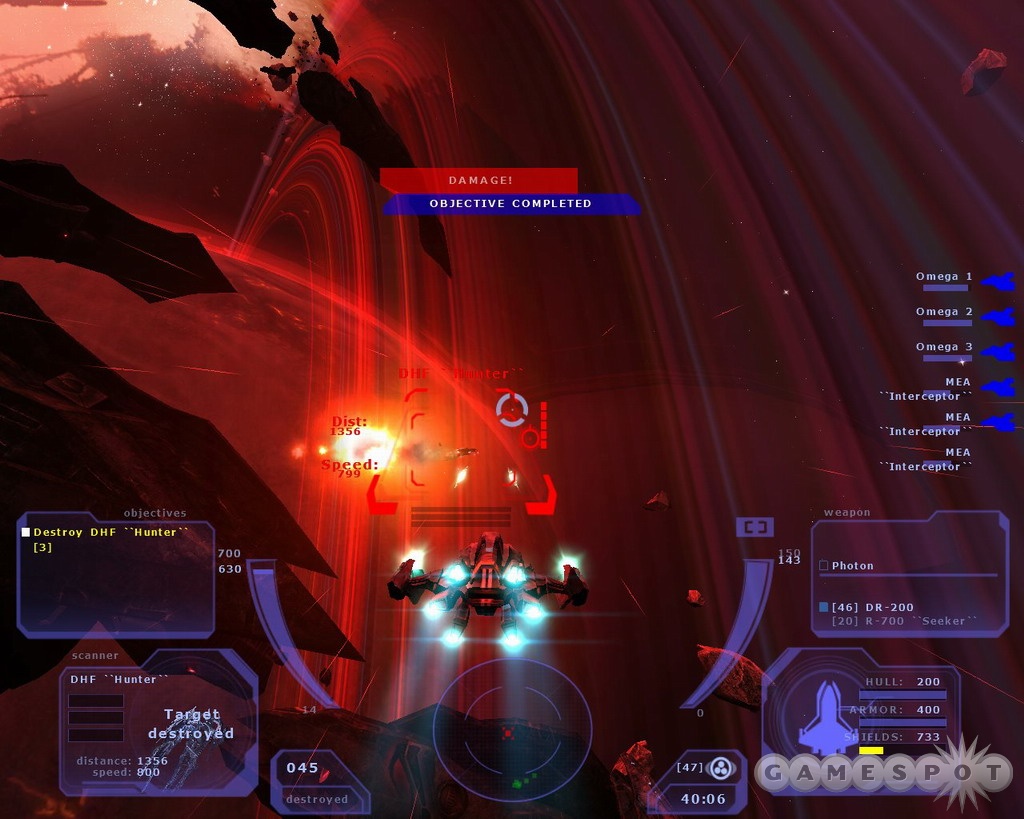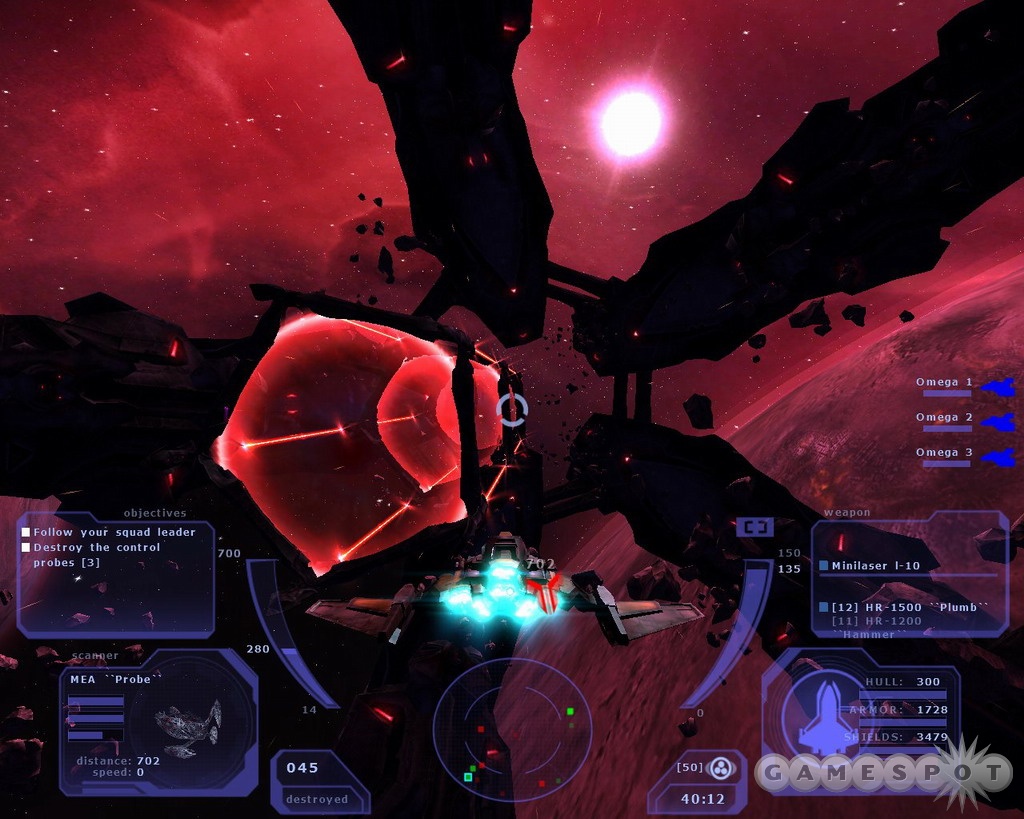English teachers should stay far away from Tarr Chronicles. Actually, let's go a little bit further and extend that caution to, well, everybody. Mangled English is probably the least of the problems afflicting this arcade-style space simulation from Russian developer Quazar Studio. Dull, repetitive missions make this one tough game to endure for very long, even when you're not puzzling over what the hell is going on due to the absolutely bizarre dialogue.
Despite Tarr Chronicles already being published in Europe earlier this year with the subtitle Sign of Ghosts, publisher Paradox Interactive put no effort into cleaning the game up for the English-speaking marketplace. This isn't the usual Russian game with garbled adjectives and no concept of how to properly use pronouns, though. On the contrary, the game's grammar is generally pretty good as far as these Russian translations go. Most of the words seem to be in the right place. But they often don't make any sense. So you get surreal descriptions like the one calling one race of creatures "anisotropic" and "multiplied in Mirrors and antiquantums." Um, yeah. Unintentionally funny phrases litter the text, too. Good luck keeping a straight face when you're assaulted by lines like "The Executioner got us all out. Like puppies from a boiling cauldron." Sorry, but, uh, yuck.

Not surprisingly, this makes the story in the solo campaign (there are no multiplayer options) impossible to follow. You're a human pilot stranded a long way from home in the far future, and the big enemy is some sort of "anti-elemental" force called the Mirk that is consuming all life in the galaxy, but beyond that the plot amounts to an alphabet soup of goofy sci-fi words like "De'Khete," "Sia'Nues," and "Varkarru." Events are hard to comprehend even when the bizarre terminology is skipped for stuff you can actually find in a dictionary. It's as if Quazar forgot to translate every second sentence, leaving you adrift in a sea of anecdotes and comments for which there is no point of reference. Pilots constantly drop names you've never heard of before and talk about unidentified "he's" and "she's" as if they were your best pals. It always seems like you're being dropped into the middle of conversations. Even the background information accessible in your cabin between missions is nonsensical. The encyclopedia refers to factions and events that remain otherwise unexplained, and your own personal log-book, presumably a journal of your experiences in the war against the Mirk, cites events that never happened and gives "war is hell" emotional heft to what seem to be lighthearted arcade furballs.
Given the head-swimming story, it's kind of a blessing that the actual gameplay is so simplistic. Tarr Chronicles is essentially a minor update on the old-school space combat sim where you pilot various fighter craft in linear battles against ever-increasing numbers of bad guys. There isn't anything new introduced here. It actually takes away at least one old amenity in joystick support, although the mouse-and-keyboard controls are smooth enough (if a bit sluggish during hard turns) that you'll never miss it. So if you pulled a Rip Van Winkle and went to sleep right after the release of Wing Commander in 1990, rest assured you could sit down and start playing this one without so much as a glance at the manual. If anything, the mission design is even more elementary than that in the nearly 20-year-old Origin classic. Virtually every assignment is a generic "destroy all enemy ships" jaunt, occasionally livened up with afterthought side objectives like escorting a capital ship, taking out weapon generators, or detonating mines.
Even when there is a specific purpose to your sorties, you still don't do anything more than zip around blasting enemy craft with energy beams and missiles. This all gets extremely mind-numbing in short order, due largely to the excessive number of opposition ships and the subpar artificial intelligence. While it's dreary enough to have to destroy a dozen or more enemy fighters in each and every mission, the bad guys make your task even more annoying by flying about in circles waiting for you to target them. It seems like the only way you can lose is when objectives are partially out of your control, as in the missions where you have to protect an allied capital ship from withering enemy fire and simply can't blast the baddies to bits fast enough. Thankfully, these moments aren't all that common, although they do occur often enough to make you curse the save system that stores your progress only at the end of what are typically multipart mission segments. Since the tougher objectives always occur at the tail end of these sections, failure typically means a lot of backtracking. Overall, there isn't a great deal of challenge on offer here, just endless repetition. The game tries your patience more than your flying skills and marksmanship.

Ship configuration is really the only interesting aspect of the game design. Different types of hardware are added to the hangar-bay loadout choices before every mission, giving you the option to trick out your ride with various reactors, guns, missiles, shields, hull armor, and the like. Choices aren't really explained very well, though. A talking-head clip of an engineer pops up to give you some highlights of one or two of the new goodies, but these brief descriptions never give you a full run-down on how such goodies help or hinder you in combat, or outline what you should equip for the task ahead. So it can be easiest to take the path of least resistance and just click the auto-configure button. Not that it's all that difficult to figure things out on your own. Stats for each modification are fairly bare-bones, and all you really need to do to custom-craft your ship is make sure that you keep the weight and energy requirements within operating parameters.
At least Tarr Chronicles looks pretty good. Although it lacks the cotton-candy nebulae that turn some space sims into galactic amusement parks, the backdrop is crammed with stars and superb lighting effects. Vessels are just a touch too dark. Many objects seem backlit by nearby suns, planets, and the bright starfield, which obscures a lot of fine details unless you get really up-close and personal. Audio is just as repetitive as the mission objectives, though. Wingmen repeat the same canned comments during furballs. You'll hear "Group, hold it together!" about once a minute. And the music seems to be a 30-second clip that loops incessantly and is so clumsily inserted into the game that there is often an audible tick when the loop restarts.
There are some things that man was not meant to know, and Tarr Chronicles is clearly one of them. But unlike so many other awful games, at least Quazar Studio doesn't hide this fact. On the contrary, it pretty much wallops you over the head with its incomprehensibility from the very moment you load it up. So, you might want to thank the developer for not wasting too much of your time, if not for anything else.
Editor's Note: This review addresses the digitally distributed version of the game.